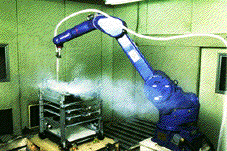 Science & Technology || Search || Back Numbers WASTE-FREE FACTORIES:
 A robot cleans used copier parts to prepare them for recycling. (Photo: Fuji Xerox Co.) A growing number of factories are recycling 100% of the waste they generate. The industrial waste that used to be incinerated or hauled away to landfills is now being used to produce cement, paving material, and other items. Companies are establishing waste-free factories despite their higher costs out of the recognition that reducing and recycling waste are part of their responsibility to society.
Waste Not, Want Not
It already had a 95% recycling rate two years ago, and it went 100% waste free by finding uses for those parts that had been discarded: glass plates are now crushed to produce paving material, and silica gel, a drying agent, is burned to produce cement material. Each year, the factory produces around 6,000 tons of waste, which are now classified into approximately 70 types, such as printing powder, plastics, used metal parts, glass, and spent oil. In addition to recycling these items in-house, the factory ships items to other companies for reprocessing. Some 54% of the waste it generates is now used to produce aluminum, cement, and other materials; 23% is processed into fuel; and the remaining 23% is reclaimed as parts. A brewery in Ibaraki Prefecture, meanwhile, achieved waste-free status in autumn 1996. The plant generates 46,000 tons of waste annually, 85% of which is beer sediment. Efforts have been made over the years to recycle this waste, such as by turning it into cow feed and marketing it to dairy farmers. To make use of the remaining 15%, the factory instated a program under which all waste is separated into 34 categories. Plastics, which had been discarded, now live again as construction material, and bottle tops are used to create iron rods used in the construction of buildings. Paper and kitchen waste are turned into ash for cement, and sludge is converted into fertilizer. An electronic machinery factory, also in Ibaraki, has set up a recycling center to convert waste into solid fuel. The facility grinds paper, wood, and plastic waste into tiny particles, which are then compressed. The heat generated from this process melts the plastic, turning the material into solid fuel. The recycling center turns 4 tons of waste a day into fuel and markets it. The factory is now competely waste-free, as separate collections are made for all types of waste, including cardboard, copying paper, used cans, and copper and aluminum scrap.
Voluntary Initiatives
These initiatives are being spearheaded not just by private companies but also by industrial associations, many of which have issued voluntary targets for their member firms The mining industry, for instance, has established a recycling target of 99% for the slag generated by nonferrous metal refineries by 2010. The rate in fiscal 1995 (April 1995 to March 1996) was 68%. The steel industry, too, is calling for a recycling ratio of 99% for the by-products of steel production by 2010. The percentage in fiscal 1990 was 95%. The electronic machinery industry, meanwhile, is calling on members to raise the recycling rate at their factories to 75% by 2010 from the 1991 average of 54%, and the shipbuilding industry has established a target of 75% or higher for the recycling of waste produced during the manufacturing process by 2010 from 58% in 1990. While targets differ from industry to industry, there is a shared sentiment that more must be done by everyone to curb the volume of waste produced. The extent to which industries and individual companies are implementing environmental programs is increasingly becoming a measure of their fulfillment of social responsibilities.
 Edited by Japan Echo Inc. based on domestic Japanese news sources. Articles
presented here are offered for reference purposes and do not necessarily
represent the policy or views of the Japanese Government.
Edited by Japan Echo Inc. based on domestic Japanese news sources. Articles
presented here are offered for reference purposes and do not necessarily
represent the policy or views of the Japanese Government.
|
